
The jaguar is the largest feline in the Americas and the only one of the Panthera genus in the entire region. It is also the third largest in the world, after the Asian tiger and the African lion.
There are 36 species of felines on the planet, which belong to the Felidae family, which inhabit all major territories, except Australia, Antarctica and Madagascar. Of the 36 species, 12 live in the American continent: 5 in the tropics, 6 in temperate or cold places and only 1, the jaguar, which lives in all environments (Ceballos 2012).
On the other hand, 5 of the 12 species of American big cats live in the Amazon basin : the ocelot ( Leopardus pardalis ) , the margay ( Leopardus wiedii ), the jaguarundi ( Herpailurus yaguouaroundi) , the puma ( Puma concolor ) and the jaguar ( Panthera onca ). Among them, the jaguar stands out for its size and strength (Ceballos 2012).

Leopard and jaguar (comparison)

Source: Natural History of Mammals (Public Domain)
Scientific name and other common names of the jaguar
The jaguar ( Panthera Onca ) goes by many vernacular names: jaguar, tiger, royal tiger, butterfly tiger; painted tiger, mountain tiger, poppy tiger, malibu tiger, black tiger, panther, otorongo and mancueva.
The name of jaguar is a derivation of the Guarani language, in which jaguara means “jumping meat eater” .
The other names that have been given depend on the region that the jaguars inhabit.
jaguar habitat
The jaguar was widely distributed throughout the American continent, from North America to Argentina, including Central America, as well as in the countries of the Amazon basin.
It is estimated that there were about 100,000 individuals around 1900.
Now, having reduced their habitat area by 50% , jaguars have disappeared from many places.
They became extinct in two countries: El Salvador and Uruguay.
They are hardly found in the United States, and it was said that they were almost extinct in Mexico, but using the camera-trap technique, a population of close to 4,000 individuals is now estimated in Mexico.
They have all but disappeared from the Pacific dry forests of Ecuador and Peru .

The jaguar is a feline that is highly resistant to climatic changes in its environment, however, it prefers humid environments near rivers and areas with dense plant conditions, although it can move in savannahs and forests of the Amazon jungle .
Its main habitat is made up of humid and dry forests, savannahs, swamps and, in some cases, even areas close to human settlements, due to the ease of obtaining food from domestic animals and livestock.
Jaguars in Ecuador
In Ecuador they are still available. There are two subspecies of jaguar: the jaguars of the western region of Ecuador (p. onca centralis), in danger of extinction, and those of the eastern region ( P. onca onca ), also in danger of extinction (Espinosa et al 2016).
Jaguars in Brazil
Of the estimated 50,000 specimens in the current population, the majority, 30,000, live in Brazilian territory.
They continue to be seen in the wild with some frequency in regions such as the Pantanal and the Cerrado, in the Amazon, and sometimes in the South American plains, to the point that in some parts of the In the Brazilian Amazon , tourist outings have been successfully organized to watch wild jaguars.
Jaguar Overview
It is a large feline, with a long and slender body, which can weigh up to 150 Kg, with solitary habits, exclusively carnivorous.
What does the jaguar eat?
It feeds both on large prey such as deer, peccary, tapir or tapir ( Tapirus terrestris ) and on medium-sized or small prey, such as amphibians , reptiles , small mammals or fish .
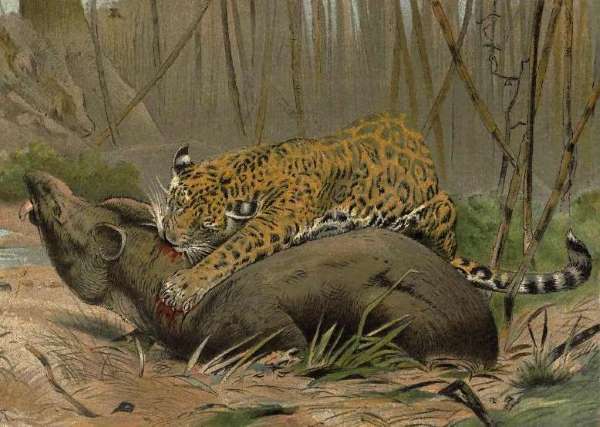
Source: The new natural history (c.1901), by Lydekker, Richard (1849-1915), Vol. 1
Author: Friedrich Wilhelm Karl Kuhnert (1865-1926) German painter and illustrator.
(Public domain)
coat and color
The jaguar has short fur, yellow and reddish on the sides, and with lighter tones towards the snout and jaws. It has black spots on the head, neck and tail.
On the pectoral and lower part of its legs it is white, with black rosettes along its body, with a central spot usually on the side and back.
black jaguar
It is possible to find specimens of jaguars with a totally black coloration. And they are called leopard, from the Latin leopardus, which means “dark lion”.
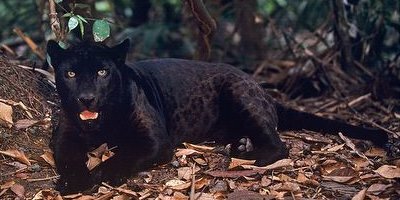
Weight
Jaguars weighing up to 158 kg have been observed, but the average weight of a male is 100 kilograms, and in females it is 70 kg.
Length
Its body can reach a length of 2.75 m, measuring from the snout to the end of its tail.
estimated life time
The jaguar subjected to captivity, as it happens in the zoo, can live up to 25 years, while in its natural environment it can reach up to twelve years, to be the feline with the greatest longevity.
The Super Powers of felines like the jaguar
All cats are alike in that they have conical tusks and large lower tusks. Most are solitary, except for lions (Panthera leo) and geopardos (Acinonyx jubatus), which live in packs.

Jaguars, like most big cats, have retractable claws that are specialized for manipulating and dominating prey that is within their reach and that resists.
They have both nocturnal and diurnal habits, so their eyes are very sensitive to changes in daylight or darkness.
The eyesight of felines exceeds up to six times the vision of humans.
Valid for that visual acuity and the colors and spots on their skin that allow them to camouflage themselves in the thick of the forest, jaguars are skilled hunters, skilled at locating and catching their prey (Payán, Soto 2012).
His sense of smell , on the other hand, is poorly developed.
But they use their whiskers , connected to nerve endings, to detect the direction of the wind and calculate the space between the branches of the forest, which helps them to move silently in the dark.
Jaguar sexual behavior
The male jaguar reaches sexual maturity between three and four years of age, while the female does so between two and two and a half years.
The mating season of the female occurs in a period between six and 17 days.
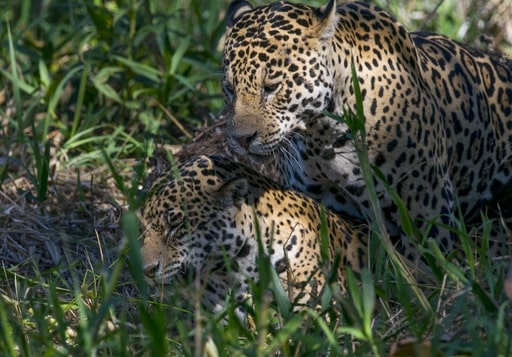
The mating process is very brief, but frequent.
The gestation period ranges from 93 to 105 days.
The female gives birth to one to four young , which feed only on breast milk until they are three months old.
Weaning occurs after five or six months, and then the young remain, in their development process, with their mother for a year and a half to two years.
Upon reaching sexual maturity, they move away from their mother to establish themselves on their own.
Habits and food.
It is a very territorial and solitary feline. Usually in the territory of a male can remain two females.
The jaguar tends to make large movements in search of food and shelter, to the point that one day they can travel up to 10 km.
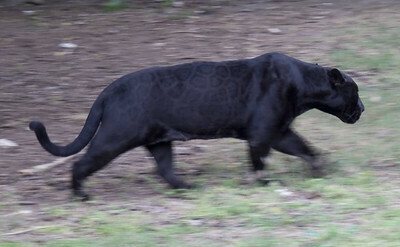
The average surface corresponding to a jaguar varies between 54 km2 to 938 km2.
Others such as Tobler et al (cited by Universidad San Francisco de Quito 2017) indicate an area of 130 km2 for females and 283 km2 for males.
The jaguar is a territorial animal. It marks its territory, scraping tree trunks with its claws, urinating on the ground or defecating on the roads it travels.
Role of the jaguar for the balance of ecosystems
The jaguar is a regulatory species of its environment, and is important for the health of the ecosystem.
The existence of carnivores affects the food chain, because their absence or decrease affects prey populations, which can multiply, increasing the pressure on the consumed vegetation, modifying the natural recovery of the forest.
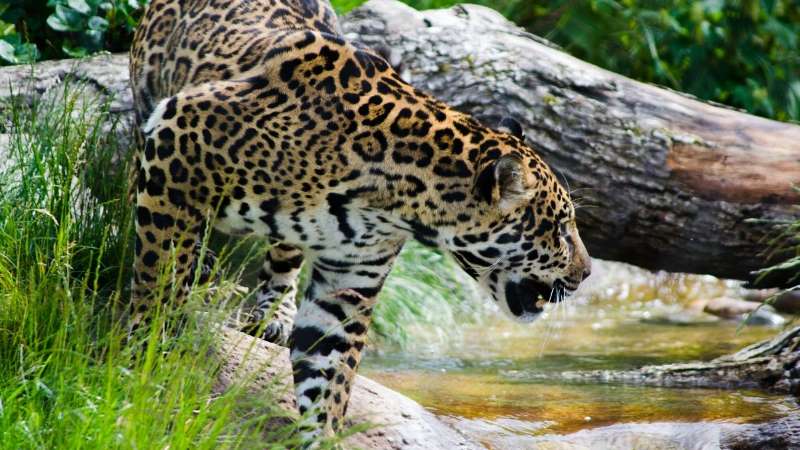
The jaguar contributes to regulating the fauna around it, reducing old and sick animals that it eliminates, while protecting others, since its living area occupies large spaces, in which it serves as a dissuasive element for the penetration of possible human occupants. .
Thus, it reduces the pressure for other species, which positions it as an essential piece for the regulation and conservation of the environment, especially in some places where it lives, as is the case in the Amazon region.
The enemies of the jaguar
The main enemies of the jaguar are the illegal hunting , deforestation , habitat fragmentation, especially due to the opening of roads and the development of human settlements, the advance of agricultural exploitation and the decrease in animal species that serve as prey, and which are essential for their food.
The jaguar is a highly endangered species , especially due to illegal hunting.
Among the threats that compromise the life of the jaguar, the most lethal is that of human groups, especially hunters and ranchers who practice extensive ranching.
Both chase, hunt and kill the jaguar.
Hunters for their skin , which they export to European, Asian and American buyers, or display as a trophy for their sporting “feat”.
The ranchers persecute it to protect their herds from the predatory action of the jaguar, since it feeds on the cattle of its extensive livestock exploitation.
In this way, in a scenario where the largest terrestrial mammals have been progressively reduced by hunting, forest fragmentation and deforestation, which shortens and intervenes the area of their habitat, the jaguar provides itself with meat, with a lower cost of energy that hunting in the savannahs or in the jungle of less abundant prey would mean, and more agile in its flight.
Threatened species
The threat against the jaguar is increasingly notorious and is advancing unstoppably, especially in unprotected forest areas. That enormous pressure has made the jaguar a near-extinct species in some places, and “near threatened” in others.
The presence of the jaguar in the Colombian Amazon , for example, began to decrease in 2006. Mainly due to poaching, sport hunting and retaliation by ranchers who put a price on the jaguar’s head (Castaño-Uribe, Ange-Jaramillo, Ramírez-Guerra, Romero 2015).
The jaguar was replaced by another big cat, the ocelot or tigrillo ( L. pardalis ), which lives even in fragmented areas, taking advantage of intervened landscape areas, which still preserve a good number of medium and small prey.
The ocelot or tigrillo replaced the jaguar in its role as regulator of animal populations. Ocelots and pumas adapt with some ease to the existence of human populations.
Hence, its ideal habitat is in the vicinity of native indigenous communities and in large protected areas, such as national parks and other animal reserve areas.
Not only for big cats, but also for large and medium mammals, such as picure (Dasyprocta punctata), armadillo (Dasypus novemcinctus), lapa (Cuniculus paca), capybara (Hydrochaeros hydrochaeris) (Morrison, Sechrest, Dimerstein, Wilcove, Lamoreux 2007 ).
In some cases, the competition between big cats and human populations increases with the decrease of the forest and the number of prey, particularly in places located in the vicinity of bodies of water, where cattle are concentrated to drink.
The last refuge of the jaguar…
The Amazon Trapeze region (Colombia, Peru and Brazil) is one of the priority research areas and is key for mammal sampling in the Amazon basin (Oliveira et al 2002).
There are not many areas left suitable for the conservation of the jaguar and other big cats.
Most are located in the Amazon, which has become, in practice, the most important habitat for the survival of the jaguar and most large land mammals, weighing more than 10 kg, dependent on lowland forests. tropical South America (Payán-Garrido, Escudero-Páez 2015; Sanders et al 2002).
A WWF study estimated the existence of some 2,000 jaguars in the Napo-Putumayo Trinational Corridor, which touches territories shared by Colombia, Peru and Ecuador, a territory that is increasingly penetrated, despite its nature reserve status.
This corridor crosses the Cuyabeno Fauna Reserve in Ecuador, the Gueppi-Sekime National Park in Peru, and the Predio Putumayo indigenous territory in Colombia.
Jaguar Populations in the Amazon
All these estimates of the existence of big cats are facilitated by the use of camera traps, a very efficient technology for this purpose. With them, distributed in large areas of possible concentration of animals such as big cats, cryptic species can be detected at any time of the night, especially for animals with nocturnal habits, to carry out inventories of species and determine their abundance and density (Payán -Garrido, Escudero-Páez 2015: 226).
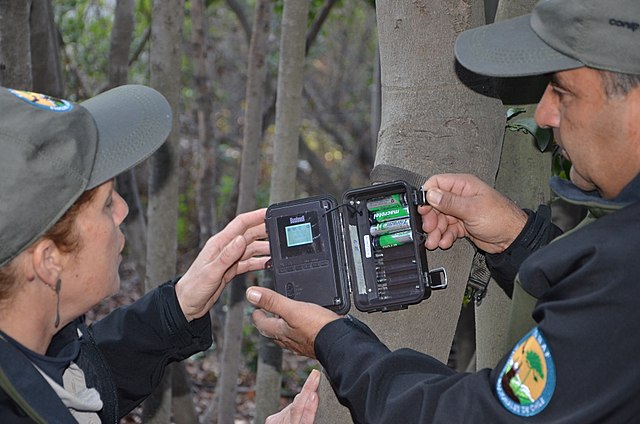
Author: Javier Ramos Pinochet / CC by SA 4.0
With the use of camera traps, it has been possible to determine the comparative density of jaguars in various regions.
In the Colombian Amazon, the density is 2.70 jaguars per 100 km2, in the eastern plains of Colombia it is 2.27 units/100 km2, in the Middle Magdalena, 4.88/100 km2, in the Bolivian Amazon , of 2.8/ 100 km2.
Payán-Garrido and Escudero-Páez (2015: 230) consider that a good estimate of jaguars in the Amazon can be 3/100 km2. These estimates of abundance and density are also made for large terrestrial mammals such as the red deer or the collared peccary.
Jaguar video captured for hours by a camera trap!
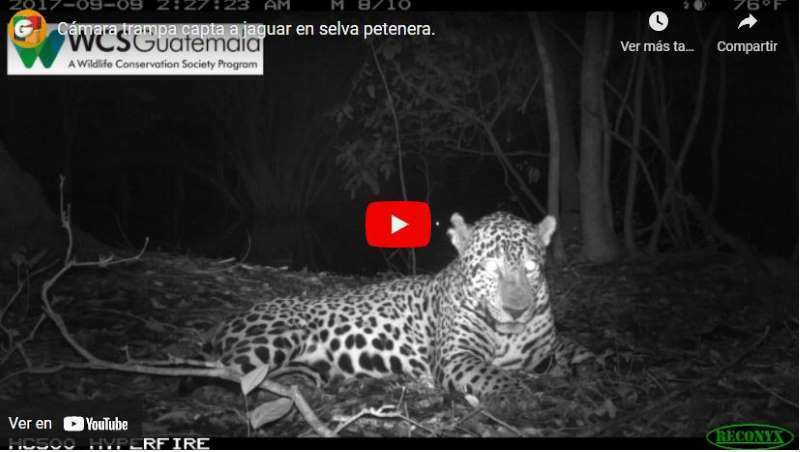
Indigenous agreements for the protection of the jaguar and other species
It is interesting to note the existence of some community agreements on indigenous lands, such as those of the upper Caura, for the conservation of large vertebrates in unprotected areas. (Perera-Romero, Polisat, Maffei, 2015).
Indigenous territorial management, of the indigenous population residing in their ancestral habitats, and in their territories, has contributed to safeguarding the conservation of large vertebrates, both in the Amazon and in the Guiana Shield.
This territorial agreement has lowered the hunting pressure on some forest animals, such as the white- cheeked peccary ( Tajacus pecari) and the tapir ( Tapirus terrestrials), as well as for the conservation of the jaguar (Castaño-Uribe, Ange-Jaramillo, Ramírez -Guerra, 2015; Perera-Romero, Polisat, Maffei 2015).
Myths and legends of the jaguar in the Amazonian culture
The jaguar has been an important reference in the creation of a whole system of relationships, practices and beliefs that exist in the different social groups, and mainly in the native Amazonian indigenous communities, a region in which there is a greater concentration of the species.
Starting from indigenous ancestral stories, even from pre-Hispanic times, to the hunters’ own narratives today, the jaguar represents a notable interest regarding cosmological, magical-religious, ritualistic themes; social and economic and, without a doubt, in the development of the culture of the Amazon region itself.
The jaguar comes to represent in indigenous culture the basic instincts of human beings, especially those who manage to “transform” into the jaguar itself seeking to imitate its audacity and strength, and acquire the ability to exterminate or dominate their peers.
In the Amazonian indigenous cosmogony , the jaguar has been greatly feared and adored by human groups since ancient times.
The shaman and the jaguar
The shaman, or sorcerer of the tribes, is symbolically transformed into a jaguar, to access the powers that the natural environment of the feline offers him.
In this case, the shaman appropriates the attributes of the jaguar to become a being with enormous spiritual and magical energies, which can be used for the benefit or harm of others, either to help or to harm, depending on the case.
The shaman faces the jaguar in the midst of a trance. If he defeats it, he can lead the energy of the universe towards good, but if he is defeated by the jaguar, he embodies the spirit of evil.
In this way, since ancient times, such an intimate relationship has been created between the jaguar and the shaman, that it was thought in ancient cultures that one was the other.
The jaguar has always been, for the cultures of North, Central and South America, a symbol of strength and power.
The jaguar in pre-Hispanic cultures.
Historically, evidence of huge stones carved with icons of jaguar men has been found. From what is inferred the degree of importance that, especially in the Mexican Olmec culture, the jaguar had in the context of the war scenarios of the indigenous groups.
Olmec
For the Olmecs , inhabitants of the jungles of the Gulf of Mexico in 1400 BC, the jaguar was their most important mythological reference.
Mayans
for the Mayans, in the Yucatan peninsula, in southern Mexico and Guatemala, the jaguar was a god of the underworld, and appears in Chilam Balam, books written anonymously in the 16th and 17th centuries, in which Balam was “the one who is mouth”, that is, the one that prophesies, the chilam, associated with presences such as that of the jaguar, and even its name in Nahuatl.
aztecs
In addition, for the Aztecs , the jaguar was the god Tezcatlipoca, the lord of shadows, due to his ability to penetrate darkness. Among them were ferocious warriors, the ocelotl warriors, who carried a jaguar skin on their back in the confrontations.
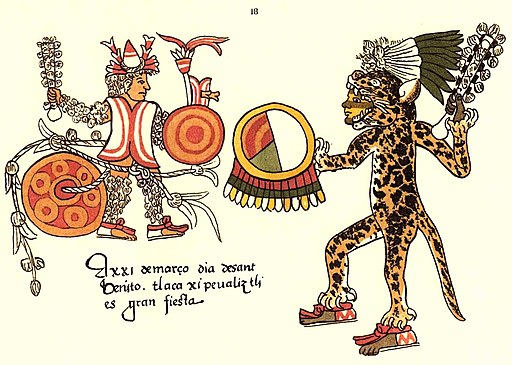
A palace to the jaguars exists in Tlatelolco, just as there are architectural monuments dedicated to the jaguar among the Mayans, as in the Mayan city of Chichen Itzá.
The jaguar in South American indigenous cultures
The jaguar was important not only in Mexican mythology, but also in South America. In the Ecuadorian indigenous culture, the jaguar acted as a mediator between men and gods.
The Waorani , for example, believe that old warriors, when they die, transform into jaguars, and that shamans have the power to move between two states: human and jaguar (Espinosa et al 2016).
The otorongo , among the indigenous people of the Peruvian Amazon, is an essential presence in the Amazon story and in the indigenous cosmogony. In the Peruvian indigenous culture, as in the Chavín culture, the jaguar is represented in different supports, especially in ceramics.
Human beings and animals share the same spiritual meaning for these cultures, Reichel-Dolmatoff (1975) points out that:
“The jaguar has often been associated with a certain number of natural phenomena such as thunder, the sun, the moon, caves, mountains, fire and also certain animals”, such as the jaguar or the snake.
Reichel-Dolmatoff (1975)
Hence the important role played by the jaguar within the indigenous cosmogony.
The jaguar is considered within this cosmogony as a deity, a god, and not just as a strong and bold animal.
In the various indigenous animist beliefs, the jaguar is an immortal being, it does not die because its indomitable spirit remains forever in the cosmos and, on occasions, it takes its spiritual form in the world of humans.
The jaguar as the main emblem of ecological tourism
The regulatory role that the jaguar plays in the ecology of environmental systems, the fear that it instills in human populations, indigenous mythology and the mystery that surrounds its presence, its relative scarcity and the symbolic significance attributed to it, have converted the jaguar in cult object for the urban observer.
Thus, a profitable flow of tourists has been created in some Amazonian regions, as is the case in some areas of tropical Africa, for the observation of jaguars in the wild.
For several decades, specifically since the 1990s, jaguar-watching tourism has been developed in some cattle ranches in the Pantanal region of Brazil (Hoogsteijn, Hoogsteijn, Tortato, Rampin, Vilas 2015). The protected natural areas of El Pantanal are located in the states of Mato Grosso and Mato Grosso de Sul.
The sighting of wild jaguars as a tourist activity: a million dollar business.
In the Pantanal there are four farms, associated with the boat-river system, in which extensive livestock coexists with jaguar-watching tourism , mainly, which is its flagship species.

Of the four haciendas, two are active tourist farms and two are jaguar protection centers. Tourist promoters who guarantee the observation of jaguars charge daily rates of US$350, and those who do not provide observation security charge US$150.
The results of the activity have been an excellent business for cattle ranches.
It is estimated that the losses caused by felines due to predation on livestock do not reach 4.11% of the gross profits generated by tourism in three livestock farms and 3.7% in the best known, the Fazenda San Francisco, in the that the income generated by this type of tourism far exceeds the losses caused by predation.
They are haciendas where prey species of felines abound. There are also accommodations for tourists: farm houses, hotels and inns.
The greatest influx of tourists in these haciendas occurs in the dry season (July to November). To realize the tourist movement already in 2012 a flow of 10 tourists was registered every hour.
The daily expenditure of each tourist is around US $300. If an average duration of three days is calculated for each visit, the cost per tourist would be US$900.
Only one of the four tourist destinations reported the annual arrival of 1,100 tourists to its hostel, generating an annual gross income of US$1 million (Hoogsteijn et al 2015: 267-269).
jaguar drawing

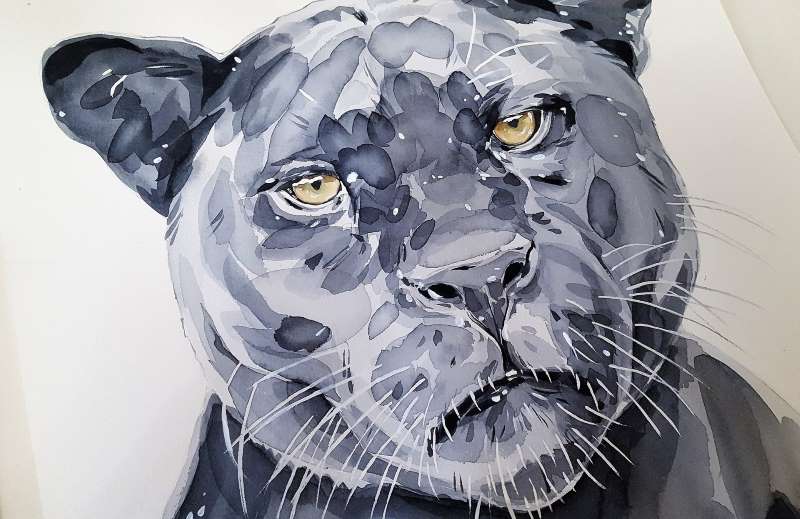
jaguar coloring


References.
- Carreno, R. (2015). Paremiology of the tiger in the Venezuelan culture. XI Venezuelan Congress of Ecology, Porlamar. PDF
- Castaño-Uribe C., Ange-Jaramillo C., Ramírez-Guerra N., Romero JF (2015). Particular considerations of felines in some buffer zones of protected areas of the Colombian Caribbean, 209-22., in: Payán-Garrido E., Lasso CA, Castaño-Uribe C. (Eds.). I. Conservation of large vertebrates in unprotected areas of Colombia, Venezuela and Brazil. Bogotá: Alexander von Humboldt Biological Resources Research Institute. PDF
- Ceballos G, List R., Medellín R., Bonacic C., Pacheco J. (2012). The cats of America. Amazing hunters. Mexico: TELMEX. Source
- Hoogesteijn R., Hoogesteijn A., Tortato FR, Rampin LE, Vilas H. May Junior JA, Sartorello L. (2015). Conservation (PO) outside protected areas: Jaguar (Panthera onca) observation tourism in private properties The Pantanal, Brazil. 259-271. in: Payán-Garrido E., Lasso CA, Castaño-Uribe C. (Eds.). I. Conservation of large vertebrates in unprotected areas of Colombia, Venezuela and Brazil. Bogotá: Alexander von Humboldt Biological Resources Research Institute.
- The felines of Yasuní. researchgate.net/publication/ 317371543_b_Los_Felinos_de_Yasuní. PDF
- Morrison J, Sechrest W, Dinerstein D, Wilcove D, Lamoreux J (2007). Persistence of large mammal faunas as indicators of global human impacts. Journal of Mammalogy, 88, 1363-1380. Source
- Oliveira D, Pisani D, Menezes DFQ, Silva E., Oliveira F., Seyffarth A. (2002). Brazilian Biodiversity to value and identify priority areas and activities for the conservation, use of their resources and distribution of benefits of Brazilian biodiversity. Brasilia: MMA/SBF. PDF
- Payán-Garrido E., Escudero-Paez S. (2015). Jaguar (Panthera onca) density and abundance of large terrestrial mammals in an unprotected area of the Colombian Amazon, 225-240. in: Payán-Garrido E., Lasso CA, Castaño-Uribe C. (Eds.). I. Conservation of large vertebrates in unprotected areas of Colombia, Venezuela and Brazil. Bogotá: Alexander von Humboldt Biological Resources Research Institute. Source
- Reichel-Dolmatoff G. (1978). The shaman and the jaguar . Mexico: Twenty-first Century Publishers. Source
- Perera-Romero L, Polisat J, Maffei L. (2015). Large terrestrial vertebrates in indigenous ancestral lands of the upper Caura: importance of community agreements for the conservation of the Venezuelan Guiana Shield, 191-208, in: Payán-Garrido E., Lasso CA, Castaño-Uribe C. (Eds.). I. Conservation of large vertebrates in unprotected areas of Colombia, Venezuela and Brazil. Bogotá: Alexander von Humboldt Biological Resources Research Institute. PDF
- Sanders EW, Redford CI, Chetkiewicz B., Medellin RA, Rabinowitz AR, Robinson JG, Taber AB (2002). Planning to know a species: the jaguar as a model. Conservation Biology, 16, 58-72. Source
- San Francisco de Quito University. (2017). The secrets of the Yasuní. Advances in Tropical Forest Research. Tiputini Biodiversity Station. Quito: USFQ. Source
- Valverde, M. (2004). The jaguar through the times and spaces of the Mayan universe. Mexico: National Autonomous University of Mexico. Source

Dr. Rafael Cartay is a Venezuelan economist, historian, and writer best known for his extensive work in gastronomy, and has received the National Nutrition Award, Gourmand World Cookbook Award, Best Kitchen Dictionary, and The Great Gold Fork. He began his research on the Amazon in 2014 and lived in Iquitos during 2015, where he wrote The Peruvian Amazon Table (2016), the Dictionary of Food and Cuisine of the Amazon Basin (2020), and the online portal delAmazonas.com, of which he is co-founder and main writer. Books by Rafael Cartay can be found on Amazon.com

Licenciado en Historia (Universidad de Los Andes), Editor Histórico e Investigador del Archivo Histórico de la Universidad de los Andes (AHULA), Especialista en Docencia Universitaria y Metodología de la Investigación (ULA), Master en Historia ULA, Doctorando en Ciencias Humanas ULA, Investigador acreditado PEII ONCTI y PEI ULA, líneas de investigación, en Ciencias Sociales, y Humanidades, Historia Económica, e Historia de la Gastronomía.
This post is also available in:
![]() Español (Spanish)
Español (Spanish)
